1.9.13: Trigonometric Functions
( \newcommand{\kernel}{\mathrm{null}\,}\)
- Convert angle measures between degrees and radians.
- Recognize the triangular and circular definitions of the basic trigonometric functions.
- Write the basic trigonometric identities.
- Identify the graphs and periods of the trigonometric functions.
- Describe the shift of a sine or cosine graph from the equation of the function.
Trigonometric functions are used to model many phenomena, including sound waves, vibrations of strings, alternating electrical current, and the motion of pendulums. In fact, almost any repetitive, or cyclical, motion can be modeled by some combination of trigonometric functions. In this section, we define the six basic trigonometric functions and look at some of the main identities involving these functions.
Radian Measure
To use trigonometric functions, we first must understand how to measure the angles. Although we can use both radians and degrees, radians are a more natural measurement because they are related directly to the unit circle, a circle with radius 1. The radian measure of an angle is defined as follows. Given an angle θ, let s be the length of the corresponding arc on the unit circle (Figure 1.9.13.1). We say the angle corresponding to the arc of length 1 has radian measure 1.
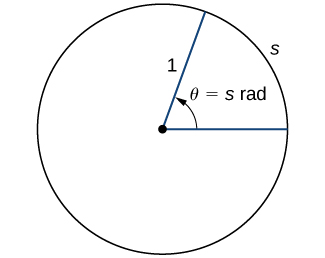
Since an angle of 360° corresponds to the circumference of a circle, or an arc of length 2π, we conclude that an angle with a degree measure of 360° has a radian measure of 2π. Similarly, we see that 180° is equivalent to π radians. Table 1.9.13.1 shows the relationship between common degree and radian values.
| Degrees | Radians | Degrees | Radians |
|---|---|---|---|
| 0 | 0 | 120 | 2π/3 |
| 30 | π/6 | 135 | 3π/4 |
| 45 | π/4 | 150 | 5π/6 |
| 60 | π/3 | 180 | π |
| 90 | π/2 |
- Express 225° using radians.
- Express 5π/3 rad using degrees.
Solution
Use the fact that 180° is equivalent to π radians as a conversion factor (Table 1.9.13.1):
1=πrad180°=180°πrad.
- 225°=225°⋅(π180°)=(5π4) rad
- 5π3 rad = 5π3⋅180°π=300°
- Express 210° using radians.
- Express 11π/6 rad using degrees.
- Hint
-
π radians is equal to 180°
- Answer
-
- 7π/6
- 330°
The Six Basic Trigonometric Functions
Trigonometric functions allow us to use angle measures, in radians or degrees, to find the coordinates of a point on any circle—not only on a unit circle—or to find an angle given a point on a circle. They also define the relationship between the sides and angles of a triangle.
To define the trigonometric functions, first consider the unit circle centered at the origin and a point P=(x,y) on the unit circle. Let θ be an angle with an initial side that lies along the positive x-axis and with a terminal side that is the line segment OP. An angle in this position is said to be in standard position (Figure 1.9.13.2). We can then define the values of the six trigonometric functions for θ in terms of the coordinates x and y.
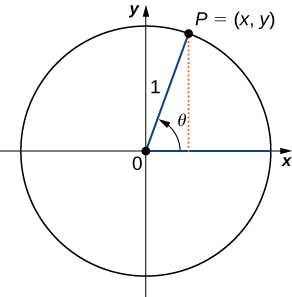
Let P=(x,y) be a point on the unit circle centered at the origin O. Let θ be an angle with an initial side along the positive x-axis and a terminal side given by the line segment OP. The trigonometric functions are then defined as
| sinθ=y | cscθ=1y |
| cosθ=x | secθ=1x |
| tanθ=yx | cotθ=xy |
If x=0,secθ and tanθ are undefined. If y=0, then cotθ and cscθ are undefined.
We can see that for a point P=(x,y) on a circle of radius r with a corresponding angle θ, the coordinates x and y satisfy
cosθ=xrx=rcosθ
and
sinθ=yry=rsinθ.
The values of the other trigonometric functions can be expressed in terms of x,y, and r (Figure 1.9.13.3).

Table 1.9.13.2 shows the values of sine and cosine at the major angles in the first quadrant. From this table, we can determine the values of sine and cosine at the corresponding angles in the other quadrants. The values of the other trigonometric functions are calculated easily from the values of sinθ and cosθ.
| θθ | sinθ | cosθ |
|---|---|---|
| 0 | 0 | 1 |
| π6 | 12 | √32 |
| π4 | √22 | √22 |
| π3 | √32 | 12 |
| π2 | 1 | 0 |
Evaluate each of the following expressions.
- sin(2π3)
- cos(−5π6)
- tan(15π4)
Solution:
a) On the unit circle, the angle θ=2π3 corresponds to the point (−12,√32). Therefore,
sin(2π3)=y=(√32).

b) An angle θ=−5π6 corresponds to a revolution in the negative direction, as shown. Therefore,
cos(−5π6)=x=−√32.

c) An angle θ=15π4=2π+7π4. Therefore, this angle corresponds to more than one revolution, as shown. Knowing the fact that an angle of 7π4 corresponds to the point (√22,−√22), we can conclude that
tan(15π4)=yx=−1.

Evaluate cos(3π/4) and sin(−π/6).
- Hint
-
Look at angles on the unit circle.
- Answer
-
cos(3π/4)=−√2/2
sin(−π/6)=−1/2
As mentioned earlier, the ratios of the side lengths of a right triangle can be expressed in terms of the trigonometric functions evaluated at either of the acute angles of the triangle. Let θ be one of the acute angles. Let A be the length of the adjacent leg, O be the length of the opposite leg, and H be the length of the hypotenuse. By inscribing the triangle into a circle of radius H, as shown in Figure 1.9.13.4, we see that A,H, and O satisfy the following relationships with θ:
| sinθ=OH | cscθ=HO |
| cosθ=AH | secθ=HA |
| tanθ=OA | cotθ=AO |

A wooden ramp is to be built with one end on the ground and the other end at the top of a short staircase. If the top of the staircase is 4 ft from the ground and the angle between the ground and the ramp is to be 10°, how long does the ramp need to be?
Solution
Let x denote the length of the ramp. In the following image, we see that x needs to satisfy the equation sin(10°)=4/x. Solving this equation for x, we see that x=4/sin(10°)≈23.035 ft.

A house painter wants to lean a 20-ft ladder against a house. If the angle between the base of the ladder and the ground is to be 60°, how far from the house should she place the base of the ladder?
- Hint
-
Draw a right triangle with hypotenuse 20.
- Answer
-
10 ft
Trigonometric Identities
A trigonometric identity is an equation involving trigonometric functions that is true for all angles θ for which the functions are defined. We can use the identities to help us solve or simplify equations. The main trigonometric identities are listed next.
Reciprocal identities
tanθ=sinθcosθ
cotθ=cosθsinθ
cscθ=1sinθ
secθ=1cosθ
Pythagorean identities
sin2θ+cos2θ=11+tan2θ=sec2θ1+cot2θ=csc2θ
Addition and subtraction formulas
sin(α±β)=sinαcosβ±cosαsinβ
cos(α±β)=cosαcosβ∓sinαsinβ
Double-angle formulas
sin(2θ)=2sinθcosθ
cos(2θ)=2cos2θ−1=1−2sin2θ=cos2θ−sin2θ
For each of the following equations, use a trigonometric identity to find all solutions.
- 1+cos(2θ)=cosθ
- sin(2θ)=tanθ
Solution
a) Using the double-angle formula for cos(2θ), we see that θ is a solution of
1+cos(2θ)=cosθ
if and only if
1+2cos2θ−1=cosθ,
which is true if and only if
2cos2θ−cosθ=0.
To solve this equation, it is important to note that we need to factor the left-hand side and not divide both sides of the equation by cosθ. The problem with dividing by cosθ is that it is possible that cosθ is zero. In fact, if we did divide both sides of the equation by cosθ, we would miss some of the solutions of the original equation. Factoring the left-hand side of the equation, we see that θ is a solution of this equation if and only if
cosθ(2cosθ−1)=0.
Since cosθ=0 when
θ=π2,π2±π,π2±2π,…,
and cosθ=1/2 when
θ=π3,π3±2π,…or θ=−π3,−π3±2π,…,
we conclude that the set of solutions to this equation is
θ=π2+nπ,θ=π3+2nπ
and
θ=−π3+2nπ,n=0,±1,±2,….
b) Using the double-angle formula for sin(2θ) and the reciprocal identity for tan(θ), the equation can be written as
2sinθcosθ=sinθcosθ.
To solve this equation, we multiply both sides by cosθ to eliminate the denominator, and say that if θ satisfies this equation, then θ satisfies the equation
2sinθcos2θ−sinθ=0.
However, we need to be a little careful here. Even if θ satisfies this new equation, it may not satisfy the original equation because, to satisfy the original equation, we would need to be able to divide both sides of the equation by cosθ. However, if cosθ=0, we cannot divide both sides of the equation by cosθ. Therefore, it is possible that we may arrive at extraneous solutions. So, at the end, it is important to check for extraneous solutions. Returning to the equation, it is important that we factor sinθ out of both terms on the left-hand side instead of dividing both sides of the equation by sinθ. Factoring the left-hand side of the equation, we can rewrite this equation as
sinθ(2cos2θ−1)=0.
Therefore, the solutions are given by the angles θ such that sinθ=0 or cos2θ=1/2. The solutions of the first equation are θ=0,±π,±2π,…. The solutions of the second equation are θ=π/4,(π/4)±(π/2),(π/4)±π,…. After checking for extraneous solutions, the set of solutions to the equation is
θ=nπ
and
θ=π4+nπ2
with n=0,±1,±2,….
Find all solutions to the equation cos(2θ)=sinθ.
- Hint
-
Use the double-angle formula for cosine (Equation ???).
- Answer
-
θ=3π2+2nπ,π6+2nπ,5π6+2nπ
for n=0,±1,±2,….
Prove the trigonometric identity 1+tan2θ=sec2θ.
Solution:
We start with the Pythagorean identity (Equation 1.9.13.15)
sin2θ+cos2θ=1.
Dividing both sides of this equation by cos2θ, we obtain
sin2θcos2θ+1=1cos2θ.
Since sinθ/cosθ=tanθ and 1/cosθ=secθ, we conclude that
tan2θ+1=sec2θ.
Prove the trigonometric identity 1+cot2θ=csc2θ.
- Answer
-
Divide both sides of the identity sin2θ+cos2θ=1 by sin2θ.
Graphs and Periods of the Trigonometric Functions
We have seen that as we travel around the unit circle, the values of the trigonometric functions repeat. We can see this pattern in the graphs of the functions. Let P=(x,y) be a point on the unit circle and let θ be the corresponding angle . Since the angle θ and θ+2π correspond to the same point P, the values of the trigonometric functions at θ and at θ+2π are the same. Consequently, the trigonometric functions are periodic functions. The period of a function f is defined to be the smallest positive value p such that f(x+p)=f(x) for all values x in the domain of f. The sine, cosine, secant, and cosecant functions have a period of 2π. Since the tangent and cotangent functions repeat on an interval of length π, their period is π (Figure 1.9.13.5).
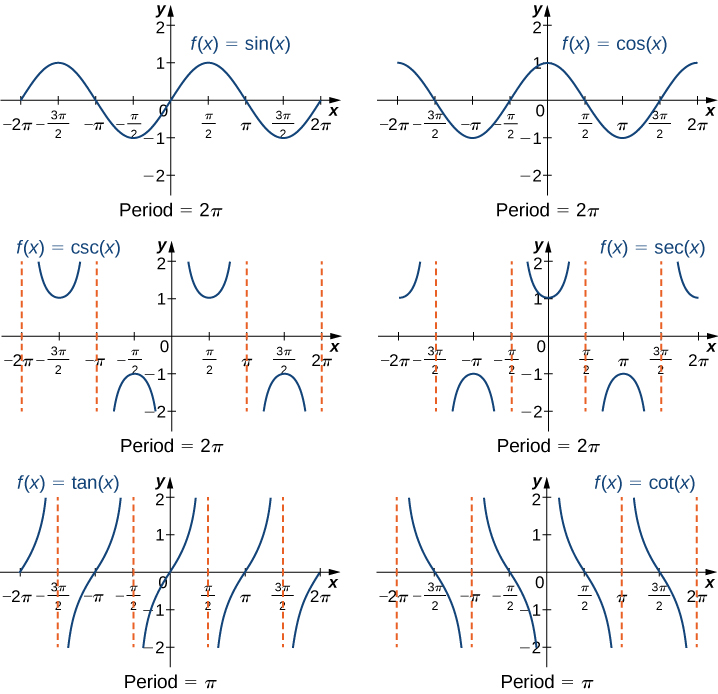
Just as with algebraic functions, we can apply transformations to trigonometric functions. In particular, consider the following function:
f(x)=Asin(B(x−α))+C.
In Figure 1.9.13.6, the constant α causes a horizontal or phase shift. The factor B changes the period. This transformed sine function will have a period 2π/|B|. The factor A results in a vertical stretch by a factor of |A|. We say |A| is the “amplitude of f.” The constant C causes a vertical shift.

Notice in Figure 1.9.13.6 that the graph of y=cosx is the graph of y=sinx shifted to the left π/2 units. Therefore, we can write
cosx=sin(x+π/2).
Similarly, we can view the graph of y=sinx as the graph of y=cosx shifted right π/2 units, and state that sinx=cos(x−π/2).
A shifted sine curve arises naturally when graphing the number of hours of daylight in a given location as a function of the day of the year. For example, suppose a city reports that June 21 is the longest day of the year with 15.7 hours and December 21 is the shortest day of the year with 8.3 hours. It can be shown that the function
h(t)=3.7sin(2π365(x−80.5))+12
is a model for the number of hours of daylight h as a function of day of the year t (Figure 1.9.13.7).

Sketch a graph of f(x)=3sin(2(x−π4))+1.
Solution
This graph is a phase shift of y=sin(x) to the right by π/4 units, followed by a horizontal compression by a factor of 2, a vertical stretch by a factor of 3, and then a vertical shift by 1 unit. The period of f is π.

Describe the relationship between the graph of f(x)=3sin(4x)−5 and the graph of y=sin(x).
- Hint
-
The graph of f can be sketched using the graph of y=\sin(x) and a sequence of three transformations.
- Answer
-
To graph f(x)=3\sin(4x)−5, the graph of y=\sin(x) needs to be compressed horizontally by a factor of 4, then stretched vertically by a factor of 3, then shifted down 5 units. The function f will have a period of π/2 and an amplitude of 3.
Inverse Trigonometric Functions
The six basic trigonometric functions are periodic, and therefore they are not one-to-one. However, if we restrict the domain of a trigonometric function to an interval where it is one-to-one, we can define its inverse. Consider the sine function. The sine function is one-to-one on an infinite number of intervals, but the standard convention is to restrict the domain to the interval \left[−\frac{π}{2},\frac{π}{2}\right]. By doing so, we define the inverse sine function on the domain [−1,1] such that for any x in the interval [−1,1], the inverse sine function tells us which angle θ in the interval \left[−\frac{π}{2},\frac{π}{2}\right] satisfies \sin θ=x. Similarly, we can restrict the domains of the other trigonometric functions to define inverse trigonometric functions, which are functions that tell us which angle in a certain interval has a specified trigonometric value.
The inverse sine function, denoted \sin^{−1} or \arcsin, and the inverse cosine function, denoted \cos^{−1} or \arccos, are defined on the domain D=\{x|−1≤x≤1\} as follows:
\sin^{−1}(x)=y
- if and only if \sin(y)=x and −\frac{π}{2}≤y≤\frac{π}{2};
\cos^{−1}(x)=y
- if and only if \cos(y)=x and 0≤y≤π.
The inverse tangent function, denoted \tan^{−1} or \arctan, and inverse cotangent function, denoted \cot^{−1} or \operatorname{arccot}, are defined on the domain D=\{x|−∞<x<∞\} as follows:
\tan^{−1}(x)=y
- if and only if \tan(y)=x and −\frac{π}{2}<y<\frac{π}{2};
\cot^{−1}(x)=y
- if and only if \cot(y)=x and 0<y<π.
The inverse cosecant function, denoted \csc^{−1} or \operatorname{arccsc}, and inverse secant function, denoted \sec^{−1} or \operatorname{arcsec}, are defined on the domain D=\{x\,|\,|x|≥1\} as follows:
\csc^{−1}(x)=y
- if and only if \csc(y)=x and −\frac{π}{2}≤y≤\frac{π}{2}, \, y≠0;
\sec^{−1}(x)=y
- if and only if \sec(y)=x and0≤y≤π, \, y≠π/2.
To graph the inverse trigonometric functions, we use the graphs of the trigonometric functions restricted to the domains defined earlier and reflect the graphs about the line y=x (Figure \PageIndex{5}).
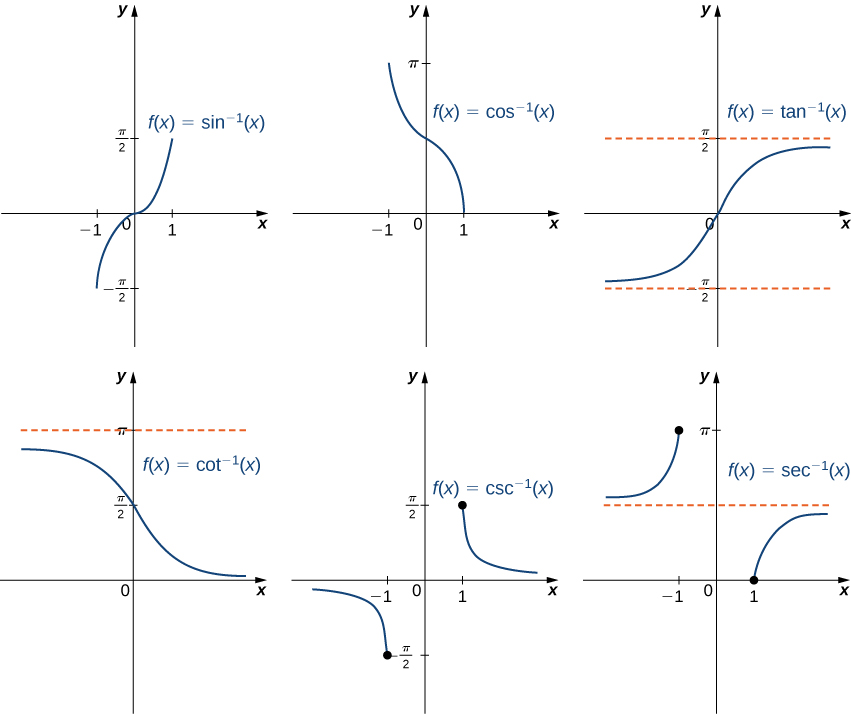
When evaluating an inverse trigonometric function, the output is an angle. For example, to evaluate \cos^{−1}\left(\frac{1}{2}\right), we need to find an angle θ such that \cos θ=\frac{1}{2}. Clearly, many angles have this property. However, given the definition of \cos^{−1}, we need the angle θ that not only solves this equation, but also lies in the interval [0,π]. We conclude that \cos^{−1}\left(\frac{1}{2}\right)=\frac{π}{3}.
We now consider a composition of a trigonometric function and its inverse. For example, consider the two expressions \sin\left(\sin^{−1}\left(\frac{\sqrt{2}}{2}\right)\right) and \sin^{−1}(\sin(π)).
For the first one, we simplify as follows:
\sin\left(\sin^{−1}\left(\frac{\sqrt{2}}{2}\right)\right)=\sin\left(\frac{π}{4}\right)=\frac{\sqrt{2}}{2}.\nonumber
For the second one, we have
\sin^{−1}(\sin(π))=\sin^{−1}(0)=0.\nonumber
The inverse function is supposed to “undo” the original function, so why isn’t \sin^{−1}(\sin(π))=π? Recalling our definition of inverse functions, a function f and its inverse f^{−1} satisfy the conditions f(f^{−1}(y))=y for all y in the domain of f^{−1} and f^{−1}(f(x))=x for all x in the domain of f, so what happened here? The issue is that the inverse sine function, \sin^{−1}, is the inverse of the restricted sine function defined on the domain \left[−\frac{π}{2},\frac{π}{2}\right]. Therefore, for x in the interval [−\frac{π}{2},\frac{π}{2}], it is true that \sin^{−1}(\sin x)=x. However, for values of x outside this interval, the equation does not hold, even though \sin^{−1}(\sin x) is defined for all real numbers x.
What about \sin(\sin^{−1}y)? Does that have a similar issue? The answer is no. Since the domain of \sin^{−1} is the interval [−1,1], we conclude that \sin\left(\sin^{−1}y\right)=y if −1≤y≤1 and the expression is not defined for other values of y. To summarize,
\sin(\sin^{−1}y)=y if −1≤y≤1
and
\sin^{−1}(\sin x)=x if −\frac{π}{2}≤x≤\frac{π}{2}.
Similarly, for the cosine function,
\cos(\cos^{−1}y)=y if −1≤y≤1
and
\cos^{−1}(\cos x)=x if 0≤x≤π.
Similar properties hold for the other trigonometric functions and their inverses.
Evaluate each of the following expressions.
- \sin^{−1}\left(−\frac{\sqrt{3}}{2}\right)
- \tan\left(\tan^{−1}\left(−\frac{1}{\sqrt{3}}\right)\right)
- \cos^{−1}\left(\cos\left(\frac{5π}{4}\right)\right)
- \sin^{−1}\left(\cos\left(\frac{2π}{3}\right)\right)
Solution
- Evaluating \sin^{−1}(−\sqrt{3}/2) is equivalent to finding the angle θ such that \sin θ=−\sqrt{3}/2 and −π/2≤θ≤π/2. The angle θ=−π/3 satisfies these two conditions. Therefore, \sin^{−1}(−\sqrt{3}/2)=−π/3.
- First we use the fact that \tan^{−1}(−1/\sqrt{3})=−π/6. Then \tan(-π/6)=−1/\sqrt{3}. Therefore, \tan(\tan^{−1}(−1/\sqrt{3}))=−1/\sqrt{3}.
- To evaluate \cos^{−1}(\cos(5π/4)),first use the fact that \cos(5π/4)=−\sqrt{2}/2. Then we need to find the angle θ such that \cos(θ)=−\sqrt{2}/2 and 0≤θ≤π. Since 3π/4 satisfies both these conditions, we have \cos^{-1}(\cos(5π/4))=\cos^{−1}(−\sqrt{2}/2))=3π/4.
- Since \cos(2π/3)=−1/2, we need to evaluate \sin^{−1}(−1/2). That is, we need to find the angle θ such that \sin(θ)=−1/2 and −π/2≤θ≤π/2. Since −π/6 satisfies both these conditions, we can conclude that \sin^{−1}(\cos(2π/3))=\sin^{−1}(−1/2)=−π/6.
In many areas of science, engineering, and mathematics, it is useful to know the maximum value a function can obtain, even if we don’t know its exact value at a given instant. For instance, if we have a function describing the strength of a roof beam, we would want to know the maximum weight the beam can support without breaking. If we have a function that describes the speed of a train, we would want to know its maximum speed before it jumps off the rails. Safe design often depends on knowing maximum values.
This project describes a simple example of a function with a maximum value that depends on two equation coefficients. We will see that maximum values can depend on several factors other than the independent variable x.
1. Consider the graph in Figure \PageIndex{6} of the function y=\sin x+\cos x. Describe its overall shape. Is it periodic? How do you know?
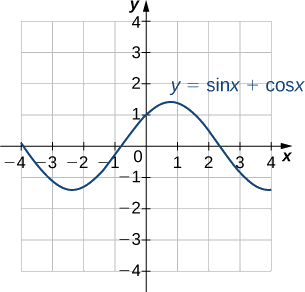
Using a graphing calculator or other graphing device, estimate the x- and y-values of the maximum point for the graph (the first such point where x > 0). It may be helpful to express the x-value as a multiple of π.
2. Now consider other graphs of the form y=A\sin x+B\cos x for various values of A and B. Sketch the graph when A = 2 and B = 1, and find the x- and y-values for the maximum point. (Remember to express the x-value as a multiple of π, if possible.) Has it moved?
3. Repeat for A = 1, \,B = 2. Is there any relationship to what you found in part (2)?
4. Complete the following table, adding a few choices of your own for A and B:
| A | B | x | y | A | B | x | y |
|---|---|---|---|---|---|---|---|
| 0 | 1 | 3 | 4 | ||||
| 1 | 0 | 4 | 3 | ||||
| 1 | 1 | \sqrt{3} | 1 | ||||
| 1 | 2 | 1 | \sqrt{3} | ||||
| 2 | 1 | 12 | 5 | ||||
| 2 | 2 | 5 | 12 |
5. Try to figure out the formula for the y-values.
6. The formula for the x-values is a little harder. The most helpful points from the table are (1,1),\, (1,\sqrt{3}),\, (\sqrt{3},1). (Hint: Consider inverse trigonometric functions.)
7. If you found formulas for parts (5) and (6), show that they work together. That is, substitute the x-value formula you found into y=A\sin x+B\cos x and simplify it to arrive at the y-value formula you found.
Key Concepts
- Radian measure is defined such that the angle associated with the arc of length 1 on the unit circle has radian measure 1. An angle with a degree measure of 180° has a radian measure of \pi rad.
- For acute angles θ,the values of the trigonometric functions are defined as ratios of two sides of a right triangle in which one of the acute angles is θ.
- For a general angle θ, let (x,y) be a point on a circle of radius r corresponding to this angle θ. The trigonometric functions can be written as ratios involving x, y, and r.
- The trigonometric functions are periodic. The sine, cosine, secant, and cosecant functions have period 2π. The tangent and cotangent functions have period π.
Key Equations
- Generalized sine function
f(x)=A \sin(B(x−α))+C
Glossary
- periodic function
- a function is periodic if it has a repeating pattern as the values of x move from left to right
- radians
- for a circular arc of length s on a circle of radius 1, the radian measure of the associated angle θ is s
- trigonometric functions
- functions of an angle defined as ratios of the lengths of the sides of a right triangle
- trigonometric identity
- an equation involving trigonometric functions that is true for all angles θ for which the functions in the equation are defined


